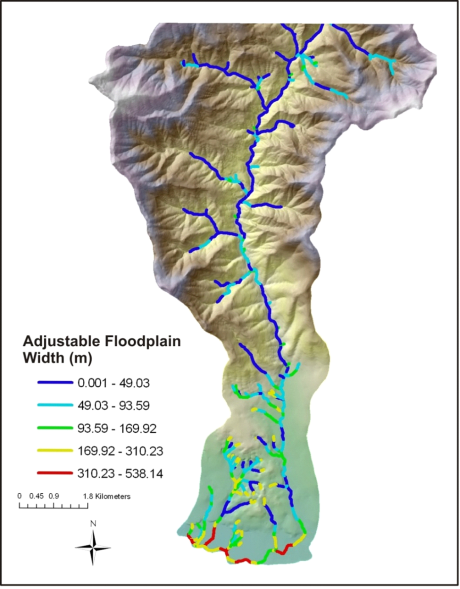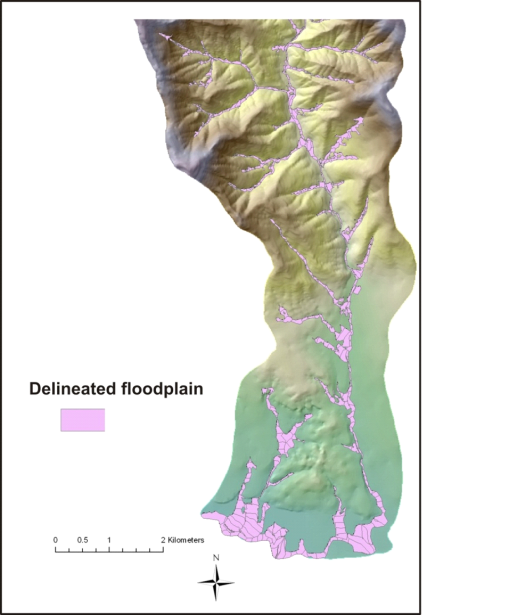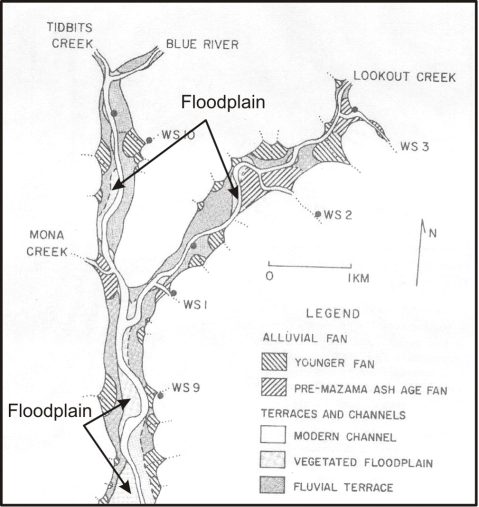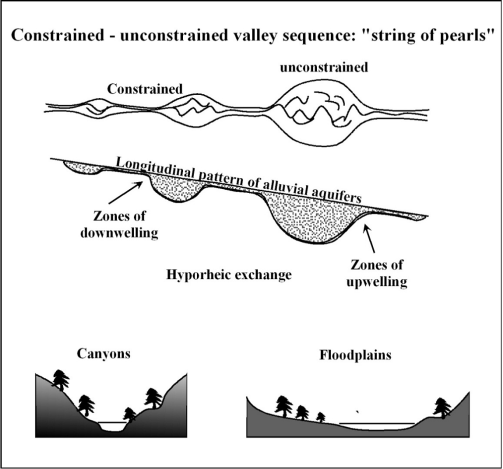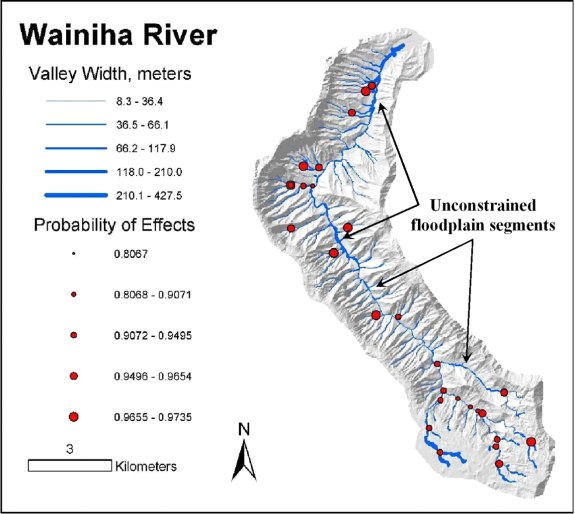NetMap's Watershed Assessment
Watershed Attribute: Floodplain (2x) - reach attribute.
The spatial extent of the floodplain is determined by an elevation above the channel (defined by the user) in units of bankfull depths.
Data Types: Line (stream layer) and polygon.
Field Name: Line attribute = FP_WIDTH;
Units: meters
NetMap Level 1 Module/Tool: Fluvial Processes/Floodplain Mapping
Model Description:
To characterize valley-floor surfaces in NetMap, DEM cells are classified according to elevation above the channel. Each cell within a specified search radius of a channel (a multiplier of bankfull widths) is associated to the closest channel cell, with distance to the channel weighted by intervening relief. Valley-floor DEM cells are associated with specific channel segments that are closest in Euclidean distance and have the fewest and smallest intervening high points. The elevation difference between each valley floor cell and the associated channel location is normalized by bankfull depth or by the absolute elevation above the channel. This procedure is repeated for every channel segment. For additional information on the use of NetMap’s floodplain mapping tool, see: http://www.hydrol-earth-syst-sci.net/15/2995/2011/ .
The floodplain tool in NetMap allows the user to specify the height about the channel from which to estimate floodplain (or valley) width in units of bankfull depths or to using a fixed elevation above the channel (Figure 1). Floodplain or valley width can vary from the right to left sides of the channel. First, the user selects the height above the channel from which to measure floodplain or valley width, either in terms of drainage area-scaled bankfull depths or in terms of a fixed elevation. Since the DEM typically does not account for the bottom of a stream channel, a bankfull depth of one could be used to define floodplains, although the Rosgen stream classification system suggests a bankfull depth of two. It is recommended that a user make field observations (and use aerial photographs) to determine an appropriate height above the channel to measure floodplain width (and an appropriate search radius, see below). The tool calculates floodplain width as a reach attribute and as a floodplain polygon. The polygon visually indicates that differences in floodplain width from the right to left sides of the channel.
Other tool options include selecting only one channel for the analysis (a channel in NetMap is defined as a linked set of stream segments that begin at the upper most channel segment [of any particular tributary] and that extends downstream until they intersect a channel [at a confluence] that has a larger drainage area). This option is designed to help clarify the floodplain extent along a single channel without the complicating and overlapping (floodplain) influences of intersecting tributaries (e.g., floodplains from mainstem channels and tributaries can interdigitate and overlap); this described in more detail below.
Figure 1. A sketch showing the location of the active floodplain within a valley that contains a small stream at summer low flow. A user selects an elevation above the channel from which to map floodplain width in units of bankfull depths or by using an absolute elevation above the channel (same for all segments regardless of channel size).
Figure 2. NetMap estimates floodplain width (combined left and right sides of channel) and that channel segment data are stored in the reach attribute table in ArcGIS.
Figure 3. NetMap identifies the extent of the floodplain (differentiates between left and right sides of channel) based on user defined bankfull depth(s) above the channel or based on an absolute elevation above the channel.
Floodplains typically lie at, or somewhat above, bankfull stage (Dunne and Leopold, 1978). In practice, zones of frequent inundation are defined by an elevation above the channel equivalent to two bankfull depths (Rosgen, 1996, Castro, 1977). To illustrate a wide range of flow inundation-valley topography relations in NetMap, multiple valley widths can be calculated, e.g., 2x, 3x, and 5x bankfull depths (Figure 4).
.
Figure 4. An example of how NetMap’s floodplain mapping tool can be used to examine variable floodplain surfaces using a range of bankfull depths above the channel (e.g., 1 x bankfull depth, 2x, and 3x etc.). Shown above is the present day (diked and regulated) channel in a basin in Northern Spain with NetMap’s predicted floodplains shown at 1x, 2x, and 3x bankfull depths. NetMap was used to develop a catchment scale perspective for river restoration in Spain (http://www.hydrol-earth-syst-sci.net/15/2995/2011/ ). Requires NetMap tools by subscription.
Technical Background
Geologic controls and major slope movements can create variations in floodplain (and valley width) and shape. Constrained (narrow) valleys typically lack sediment storage while unconstrained (wide) valley segments act as storage reservoirs of alluvial sediment, often creating wide, more complex floodplains within the fluvial landscape (Grant and Swanson, 1995, McDowell, 2001). At the upstream transition from unconstrained to constrained valley segments, a bottleneck in the transfer of sediment can occur, often enhanced by logjams. Increased sediment storage at the transition promotes heightened connectivity between channels and adjacent valley floors. The transition from unconstrained to constrained segments also enhances hyporheic downwelling (Figure 5). At the downstream transition from constrained to unconstrained valley segments, increased sediment deposition, flow divergence, and hyporheic upwelling can occur (Edwards, 1998). Thus, there is typically greater channel-valley connectivity and hence larger fluvial landscapes immediately above and below valley constrictions, with increased occurrence of floodplains, side channels, and riverine wetlands (Baxter, 2001). Alternating constrained and unconstrained river segments promote patchy heterogeneity in fluvial processes and riparian environments, a pattern often referred to as a “string of pearls” (Standford and Ward, 1988) (Figure 6).
Constrained channel segments are often characterized by rapids and bedrock influenced morphology resulting in channels being less sensitive to changes in discharge or fluctuating sediment supply. In contrast, unconstrained floodplain segments store greater volumes of sediment and wood, contain a greater diversity of low-gradient habitats, and are more sensitive to disturbances. Typically, wide valley floors promote formation of wider channels and floodplains (Grant and Swanson 1995, Benda et al. 2003b), higher sinuosity (McDowell 2001), deeper pools (McDowell 2001), greater side channels (Baxter 2001), increased gravel substrate (Perkins 2000), and valley-paralleling side channels.
River floodplains are one of the most geomorphically and ecologically significant components of the fluvial system. The active floodplain is a transition landform between a stream or river and its valley. Floodplain landforms are often interdigitated with alluvial fans and higher elevation modern and ancient terraces (Figure 5).
Locations of floodplains and their association with tributary confluences (see ‘Confluence Environments’ in NetMap’s Fluvial Morphology Module’) can be used to identify provisional biological hotspots (Figure 7). To view how NetMap’s floodplain and tributary confluence tools can be used in reconstructing fluvial landscapes for planning restoration, see: http://www.hydrol-earth-syst-sci.net/15/2995/2011/
Polygon maps of floodplains are also used in NetMap to identify roads that intersect floodplain.
Figure 5. An example of variable floodplain widths and the diminution of floodplains in upstream parts of a mountain stream network (From Swanson, F.J., and James, M.E., 1975, Geology and geomorphology of the H.J. Andrews Experimental Forest, Western Cascades, Oregon: Pacific Northwest Experiment Station, USDA Forest Service ReseFieldh Paper PNW-188, 14 p.)
Figure 6. The alternating pattern of constrained valleys (canyons) and unconstrained segments (floodplains) are important in controlling the types, abundance, and spatial distribution of aquatic and riparian habitats within watersheds. Unconstrained floodplain segments generally offer higher quality and more diverse habitats compared to canyons. Discontinuous pattern of floodplain segments in rivers have been referred to as a “string of pearls” (Ward et al. 2002). Figure adapted from Ward et al. 2002.
Figure 7. NetMap is used to predict floodplain widths across entire drainage basins and hence the amounts and locations of canyon and floodplain segments. These maps, in addition to predictions of geomorphically significant confluences, are used to identify areas of the potentially best habitats (biological hotspots). Because of the resolution of 10-m digital elevation data, the relative variation in floodplain and valley widths is more accurate than the absolute measures.


